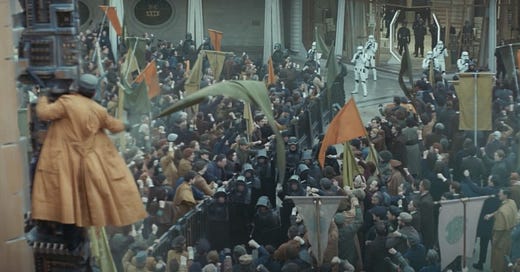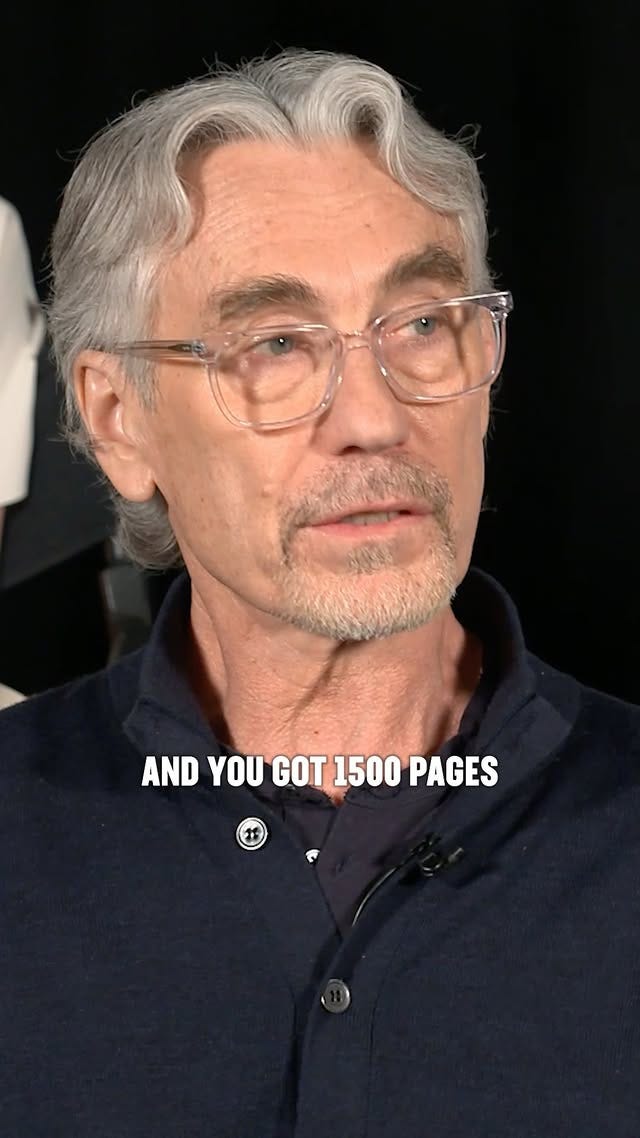Culture is a collective library of other people’s wisdom and knowledge — ways of acting, ways of seeing, ways of putting our feelings and intuitions into words and song. We can pull from this library to help us imagine things that are over the horizon of our personal experience. Sometimes what we pull out of that library lets us peer helpfully around experiential corners, and other times it leads us into delusions and mirages.
Novels, TV shows, plays, and films let us experience dilemmas and dangers we have rarely or never encountered first-hand, and give us access to perspectives we haven’t or can’t take in our everyday lives. Often fiction gives us memories of the future, so that when we’re thrown into a situation that’s new to us, we have a sense that it’s actually familiar — it’s something we’ve already seen someplace else.
Film and TV can set our expectations for rare-but-consequential events, encounters that often become turning points in people’s lives. That expectation-setting has real consequences for society because mass media ends up warping behavior at scale1.
Think about childbirth, for example, which is universal (all of us experience it at least once, though that first time we’re too young to make much sense of it) and consequential but temporally rare. For most of human history, when childbirth happened mostly in the home (and, relative to today, much more frequently), it was a regular feature of the social landscape. But today it happens almost entirely in hospitals, attended by doctors and nurses instead of by family and community midwives. Now for many of us, until and unless we experience it ourselves as adults, our major reference points for pregnancy and labor come from depictions of it on TV. There’s an entire medical literature on this, especially how media portrayals shape women’s expectations — as one paper puts it, TV “often portrays birth as risky, dramatic and painful and there is evidence that this has a negative effect on childbirth in society, through the increasing anticipation of negative outcomes.”
Disasters and political upheaval are also, obviously, rare and consequential events, and for these too film and TV often serve as people’s major reference points. I’ve written before about how decades of portrayals of pandemics in the media did us a disservice by priming the popular imagination to expect future plagues to be civilization-killers, and that anything less is not to be taken seriously (there are exceptions to this, notably Steven Soderbergh’s Contagion, which found a second life in the early months of the Covid pandemic).
When it comes to political crisis, media portrayals present a similar problem. We tend to see politics portrayed on TV and film as a series of fast-moving, clearly discernible maneuvers and confrontations between heroic and villainous individuals. What gets lost, because it isn’t important to the story, is any sense of the weight exerted by the broader social context in which these characters are acting. That’s especially true because most stories in film and TV are told, as Zeynep Tufekci put it, in the psychological rather than sociological register: as stories about individual personalities, rather than about the systems they inhabit.
In sociological storytelling, on the other hand, characters shape and are shaped by the social forces and opportunity structures of the worlds around them. This sort of storytelling is uncommon, and difficult to pull off, but there are some great examples, mostly in “prestige” television — Game of Thrones and The Wire come to mind, along with The Americans, The Expanse and The Pitt. To that list we have to add Andor, the Star Wars prequel series that just finished its run this month.
Andor is remarkable because it’s beautifully produced, shot, and acted, but also because it pulls off this incredible inversion in the Star Wars narrative universe, transposing a franchise that’s almost exclusively about individual troubles into an exploration of social problems2.
A little background: Andor fills in the backstory of Rogue One, a movie which itself fills in the backstory of Star Wars: A New Hope, the 1977 film that kicked off the franchise. The original Star Wars trilogy is a family psychodrama — Luke Skywalker turns out to be on a mythic quest to find and redeem his missing (evil?) father, and incidentally there’s a galactic civil war going on between an evil Empire and a heroic Rebellion against it, and the outcome of the whole conflict rests on Luke and his father coming to terms. (Maybe it’s not a coincidence that the Hollywood era that gave us Kramer vs Kramer also produced this string of sci-fi epics using space aliens as metaphors for being alienated from your dad, including, famously, E.T.3, though really now I’m straying into territory better covered by our good friends at Ordinary Unhappiness). It’s really compelling, don’t get me wrong! The original Star Wars isn’t supposed to be a weighty social commentary, and it’s not a critique of the thing to point out that it isn’t.
Anyway as Luke moves along his hero’s journey in the first film we’re introduced to this moon-sized space super-weapon being built by the Empire, called The Death Star. Mostly it exists as a narrative device, a physical manifestation of Luke’s struggle with his dark father. It has no social gravity — it can be built and destroyed at the wave of a hand.
In Andor, on the other hand, the Death Star is the focus of a Manhattan Project-style industrial science program the material and political necessities of which subtly but consequentially warp life across the galaxy. It exists entirely offscreen and is hardly ever mentioned, but its constuction bends the narrative arcs of every character in ways that they themselves don’t necessarily see or understand (spoilers in this footnote4). The series is nominally about a group of rebels who eventually steal the blueprints for the Death Star, the MacGuffin that opens Star Wars: A New Hope. But really, as creator Tony Gilroy explains, the show is a novelistic exploration of the social conditions and dynamics of totalitarianism and revolution, to which Gilroy brought a lifelong interest in the study of revolutionary history:
It’s a show about Who Goes Nazi and why, about the banality of evil, the coalitional problems of left-wing politics, about the material constraints of political struggle and contingency of history, a dramatization of the slow Gleichschaltung of an authoritarian government overwriting a democratic republic. Timely! But also the show approaches its characters and central conflicts the way sociologists approach conflicts in the social world — as Peter Berger described it in his great (though somewhat dated) Invitation to Sociology:
The ‘problems’ that the sociologist will want to solve concern an understanding of the entire social situation, the values and modes of action in both systems, and the way in which the two systems coexist in space and time. Indeed, this very ability to look at a situation from the vantage points of competing systems of interpretation is … one of the hallmarks of sociological consciousness.
By its nature, TV and film usually reduce politics to personality clashes, aesthetic choices and narrative contrivance. In those stories we get good guys and bad guys, who are good or bad according to their nature (or the demands of the plot). In shows and films told in the sociological register, like Andor, we get an exploration of how it’s possible for everyone, on all sides, to understand themselves as the hero of the story, and how their position in their social system influences how they see the world and how they enact their values and pursue their goals under those constraints (spoilers again5).
Politics is a slow boring of hard boards in Andor. The rebellion is fractious, it moves slowly, it needs money and constant attention to organizing. At one point, a rebellion-aligned senator gives a rousing speech in defiance of the state’s official narrative but, as so often in real life, it doesn’t actually accomplish anything aside from rearranging the social position of the senator herself. Characters’ personal ambitions get yoked to larger institutional projects over which they have only limited influence. They get pulled along by the tidal forces of bureaucracy or social moments. In the same way that George Lucas made the original Star Wars films as a pastiche of Flash Gordon serials, samurai films, and Joseph Campbell’s comparative mythology, Tony Gilroy builds Andor from the likes of Battle of Algiers, Les Miserables, Army of Shadows, and For Whom The Bell Tolls — stories about the moral complexities of political struggle.
What I think is so special here isn’t so much that Andor treats politics this way, but that it does so from within a colossal pop culture franchise that is otherwise committed to treating politics as an asethetic backdrop to individual personality — as a team or a brand you choose, rather than as something with material and social consequences. It’s a thrilling and reflective show, something worth spending your time with. It’s also encouraging, in a pretty grim moment in history, that a show with this kind of a commitment to a sociological depiction of political struggle is finding such a broad audience alongside its critical acclaim.
I’m thinking here especially about what Erving Goffman called “people processing encounters,” specific situations with potential to change our status by presenting us with gates through which we may or may not pass as a result of our interactions with other people — situations that shape and are shaped by the larger institutional order. Job interviews, police encounters, dates, weddings, etc. These kinds of encounters can have major and lasting effects on our life chances, and to the extent that mass media patterns people’s behavior in these situations, it can produce patterns of stratification across society.
It’s like, imagine someone made a prequel series to Friends, but it’s a Show Me A Hero-style tragedy about the zoning struggles around Monica’s Greenwich Village apartment building.
I think a lot about a passage from Jon Mooallem’s 2022 profile of Noah Baumbach recounting a family trip to a press screening of E.T. in 1982, and listen if you’ve followed me to the footnote in a parenthetical you might as well go all the way and read the article for yourself.
There’s a beautiful symmetry in how Cassian Andor and the Death Star coalesce in parallel across the show. In the first season Andor is swept up in a random police action and sent to a labor camp where he’s forced to build these widgets none of the characters understand — they turn out to be components for the Death Star. He’s sent to the planet Ghorman to assess a resistance movement there — it turns out the Empire is ginning up a confrontation with the locals there as an excuse to relocate the population, becuase it needs to strip mine the planet for a mineral critical to the construction of the Death Star’s power reactor.
Cyril Karn is maybe the show’s best example of this — he’s just a guy who wants rules to be followed and justice to be done. Under different conditions you could easily imagine him turning to the Rebellion. But he’s a striver, born in the imperial core, and so he starts off as a corporate security officer, and climbs the imperial career ladder trying to fight “outside agitators” until he discovers, too late, that what he has been serving isn’t justice, but merely power.




